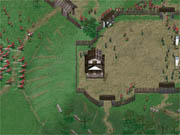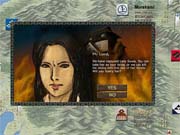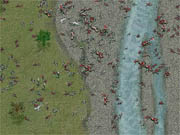Takeda is not a rip-off of Shogun: Total War. Magitech's real-time epic might share a setting with the reigning daimyo of medieval Japanese military sims, but it isn't a slavish copy. Unfortunately, it might have fared better if it were. For although Takeda is original, a combination of questionable design decisions and serious technical issues make it tough to play, let alone enjoy. While there are a few high points, the presence of so many rough edges makes this game one for the "could have been" bin.

Many of Takeda's problems stem from its unfinished state. This fact is openly acknowledged in the troubleshooting section at the back of the manual. Unbelievably, the designers admit here that the game for which you just plunked down $44.99 "is still under development" and that "current versions are not fully optimized." As a result, "slowness may be a problem on many systems." Ours is one of them. The Athlon XP 1700 used to play the game, which incidentally sports 512MB of RAM and a lightning-fast GeForce3 Ti 500 video card, had trouble running the game at all. Choppiness makes it very difficult to scroll across the battlefield. Animations are similarly afflicted, turning battles into jerky affairs more appropriate to marionettes than flesh-and-blood soldiers. Disabling the environmental effects and drifting fog speeds things up a bit, as does hitting "0" to maximize the frame rate, though stuttering remains a serious encumbrance to smooth play. Strangely, you can't change the fixed screen resolution of 1280x1024.
Other barriers also exist. The overall presentation is devoid of extras, some of which we've come to expect in real-time strategy games. For instance, there is no way to alter the default camera angle. This setting is locked in a position that is of sufficient height to turn individual soldiers into tiny colored blobs, but not high enough to provide a complete overview of the battlefield. A lot of scrolling is required, even when dealing with the smallest conflicts. Seeing as scrolling is such a challenge, this limitation adds frustration to every battle. It can be somewhat difficult to even make it this far, as Magitech omitted both an in-game tutorial and tooltips. The manual is helpful, although some of the information about the interface has been shunted to a .pdf file included on the game disc. Such skimpy production values can also be heard in a title song that wouldn't have been out of place on the Sega Genesis. Sound effects are similarly retro, consisting of clanging steel, horses' hooves, and a lot of accent-tinged voices screaming "Arrggghhh!" One Japanese command is shouted over and over again during every battle.

If you can get past these obstacles, Takeda does have a few good things to offer. Magitech has a solid grasp on Japanese history, telling the fascinating story of the nation's 16th-century civil war in a deep and involving campaign. As the title suggests, you assume control of Clan Takeda in the middle of its battle for survival. Command your forces well and you'll soon go on the offensive, eventually battling for control of the entire island. Though the campaign is scripted, how you succeed or fail on the battlefield does set up your position for subsequent combat. A victory usually places you in good shape for the next battle, while being slaughtered can be so disastrous that subsequent battles are all but unwinnable. This dynamic element lends a lot of drive and realism to the campaign, in that you can get on a roll and rip through four or five clashes without breaking a sweat, or you can screw up and find the consequences of that mistake following you around. Historical battle mode offers a further 13 authentic engagements from the civil war and three fictional ones based on "what if?" speculation. Most of the significant events of the period are available, including the siege of Katsurao and the climactic battle of Sekigahara.
A multiplayer option is provided as well, though Magitech really missed the mark there. Instead of allowing combat between multiple clans--a natural considering the civil war backdrop that pitted faction against faction against faction--LAN and Internet battles are head-to-head only. GameSpy Arcade support is included, though it can't be accessed from the game itself, which features only direct IP connections. Online opponents were few and far between as of this writing, at any rate.

Gameplay is almost entirely about combat. The lone exception involves occasional events during the campaign that call for you to supply a yes-or-no answer to marriage alliances, pacts with other clans, and the like. However, it's hard to tell what effect these actions have on your forces, as feedback regarding the wisdom of your selection is limited to vague notes such as "Some of your generals are unhappy." Much of the time, you'll be free to concentrate solely on organizing your forces. This is done via a deployment screen where you look over the available divisions and slot them into center, flanking, headquarters, and reserve positions. There are also three detachment slots available if you want to hold a battalion back for either a strike mission to flank the enemy in the later stages of a battle or a delay mission to counter an enemy strike force.
Divisions are composed of battalions featuring up to five different unit types--spearmen, swordsmen, archers, cavalry, and (eventually) riflemen--that are under the authority of generals and officers. These commanders are rated in terms of leadership ability, and this score trickles down to the troops in their charge in separate skill, experience, morale, and bravery stats. Battlefield results also play a part in how these numbers are calculated. Showing Magitech's respect for Japanese history, the game also builds a battalion's bravery score by tracking the number of rival flags cut down and the number of enemy officer heads that have been cut off (for display to the clan lord as a token of respect). Once your basic lines have been set, you choose from more than a dozen formations. These include a variety of designs good for general offensive (wave, spear, and so on) and defensive (open wing, circle, and so on) purposes, as well as for specific objectives like a siege or a quick-strike assault. Formations can also be changed on the fly after the battle begins. This is occasionally necessary to deal with terrain or changing weather. Rivers, dense forests, hills, and mist all affect battlefield conditions, sometimes seriously. Giving an enemy the high ground, for example, can be suicidal.

More problems emerge after the battle begins. Battalions are commanded en masse with eight orders that run the gamut from simply moving to a new position to all-out attacking, regrouping, and retreating. This list is remarkably complete, though units often don't respond the way they should. It can be very difficult to position troops effectively in large-scale battles or during sieges. Attempting to concentrate your forces on a single objective--such as a castle gate or a vulnerable flank--often results in confusion. Orders to smash through one gate, for example, always lead to soldiers thinning out and attempting to get through another entrance or even the supposedly impregnable wall. That this happens is noted in the manual, though why it should be taking place is left a mystery. It happens even with the most experienced, courageous men, so it seems to be a flaw in the artificial intelligence. Part of the cause could be the lack of commands for specific actions, like breaking down a gate or cutting an enemy flag to harm their morale. Such events are supposed to happen automatically whenever your soldiers are in the right area, though this obviously isn't occurring a substantial amount of the time.
Despite these bouts with chaos, Takeda can occasionally be quite gratifying. Establishing and then operating from killer formations, with cavalry in the perfect positions to devastate the enemy, is very satisfying. Breaking into the opposition's headquarters and cutting down its flags provide an undeniable sense of achievement. Even the lofty camera angle is good at showing the devastation wrought in battle. Still, these moments just don't take place as often as they should, and technical problems shroud the entire experience with the feeling that you've paid to play a beta. And that's unforgivable, good moments or not.